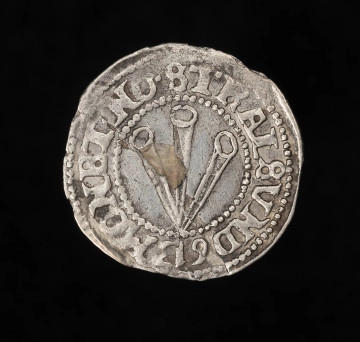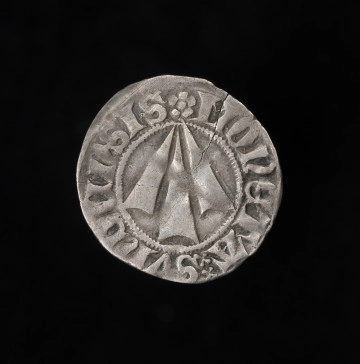
Groschen (Kreuzgroschen)
1613
National Museum in Szczecin
Part of the collection: Pomeranian coins
After Sweden entered the Seven Years’ War (1757–1762), it urgently needed funds to pay its army. In 1758, King Adolf Frederick (1710–1771) authorised the lease of the royal mint in Stralsund and the production of debased coinage. The mint was taken over by bankers who withdrew older coins from circulation and re-struck them with progressively lower silver content. Circulating coins, such as 1/3, 1/6, 1/12, 1/24, and 1/48 thalers, were minted with varying silver purity and specially marked. The entire operation was kept secret, and as production increased, so did the workforce. By 1759, the mint employed 65 workers and used 12 horses. Unemployed labourers and craftsmen from unrelated trades, such as weavers, stocking makers, and fishermen, were trained for minting. In 1760, the mint was placed back under direct royal administration, but the quality of its coins deteriorated further. Enormous amounts of low-value small denominations flooded the market. Billon schillings were struck for two years (1760–1761) using a minting standard that had reached 41¼ thalers per mark of silver. These debased coins, similar to the inflationary schillings circulating in Prussia and Mecklenburg, contributed to the disruption of the monetary system. In 1761, the coin dies began featuring the initials of four mintmasters. Only a select few knew the secret behind the markings, which was only exposed after the war when the depreciated currency was exchanged. The variety and inconsistency of these marks suggest deliberate deception, especially since some small denominations were never redeemed. In the case of schillings, dots were used as indicators, placed either near the mintmasters’ initials or the date. Coins without these dots contained slightly more silver and were exchanged at a better rate. The coin on display fully illustrates the collapse of the silver standard. It is made from such poor-quality metal that it appears to be copper coated with a thin layer of silver. Genowefa Horoszko
Author / creator
Object type
coin
Technique
coining
Material
silver
Origin / acquisition method
acquisition
Creation time / dating
Creation / finding place
Owner
The National Museum in Szczecin
Identification number
Location / status

1613
National Museum in Szczecin

1367 — 1380
National Museum in Szczecin

1506
National Museum in Szczecin
DISCOVER this TOPIC
National Museum in Lublin
DISCOVER this PATH
Educational path